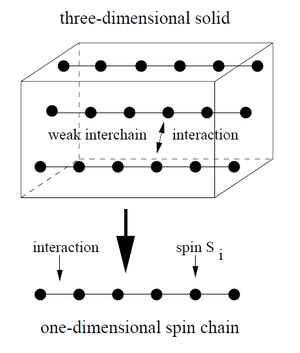S=1/2 and S=1 one dimensional quantum magnets
Why are we interested in one-dimensional magnetism? Magnetism in one dimension are of highly theoretical interest as well as there are a variety of highly interesting experimental systems. Most two-dimensional magnets order at T=0, however, in one-dimensional situation, fluctuations are so strong that at T=0 most magnets are disordered. Because of the strong fluctuations, conventional techniques are normally not applicable. So we need to search for new tools to solve problems. One of the representative way is to use numerical methods. An example is, by numerically evaluation, one found a unique, disorder ground state of the nearest-neighbor isotropic anti-ferromagnetic Heisenberg chain for spins S=1/2, with anti-ferromagnetic spin-spin correlations, referred as quasi long-range ordered.
Haldane's Conjecture
Introduction to Haldane's Conjecture
Haldane conjectured a fundamental difference between spin chains with S an integer and S a half-integer. He mapped out anti-ferromagnetic isotropic Heisenberg chains to an effective low-energy long-wavelength field theory. Here we use effective field theories of anti-ferromagnets to show Haldane's Conjecture.
Let's consider an isotropic anti-ferromagnetic Heisenberg model with nearest neighbor interaction between spins of S length.The Hamiltonian can be expressed as
- Failed to parse (SVG (MathML can be enabled via browser plugin): Invalid response ("Math extension cannot connect to Restbase.") from server "https://wikimedia.org/api/rest_v1/":): {\displaystyle \mathcal{H}=J\sum_{i=1}^N \mathbf{S}_i \mathbf{S}_j \qquad J>0}
Assume that local Failed to parse (SVG (MathML can be enabled via browser plugin): Invalid response ("Math extension cannot connect to Restbase.") from server "https://wikimedia.org/api/rest_v1/":): {\displaystyle N\acute{e}el} order on short length scales, we can derive an effective long-wavelength low energy Lagrangian for Failed to parse (SVG (MathML can be enabled via browser plugin): Invalid response ("Math extension cannot connect to Restbase.") from server "https://wikimedia.org/api/rest_v1/":): {\displaystyle S\rightarrow\infty}
- Failed to parse (SVG (MathML can be enabled via browser plugin): Invalid response ("Math extension cannot connect to Restbase.") from server "https://wikimedia.org/api/rest_v1/":): {\displaystyle \mathcal{L}=\frac{v}{2g}\partial_{\mu}\overset{\rightarrow}{\phi}\partial^{\mu}\overset{\rightarrow}{\phi}+\frac{\Theta}{8\pi}\epsilon^{\mu\nu}\overset{\rightarrow}{\phi}\left(\partial_{\mu}\overset{\rightarrow}{\phi}\times\partial_{\mu}\overset{\rightarrow}{\phi} \right)}
Where v=2JS is the spin wave velocity, g=2/S is the coupling constant and Failed to parse (SVG (MathML can be enabled via browser plugin): Invalid response ("Math extension cannot connect to Restbase.") from server "https://wikimedia.org/api/rest_v1/":): {\displaystyle \Theta=2\pi S} is the topological angle; Failed to parse (SVG (MathML can be enabled via browser plugin): Invalid response ("Math extension cannot connect to Restbase.") from server "https://wikimedia.org/api/rest_v1/":): {\displaystyle \overset{\rightarrow}{\phi}} is a three-component unit vector field. Then we can do a Wick rotation to get the form of Lagrangian as below:
- Failed to parse (SVG (MathML can be enabled via browser plugin): Invalid response ("Math extension cannot connect to Restbase.") from server "https://wikimedia.org/api/rest_v1/":): {\displaystyle \mathcal{L}=\mathcal{L}_{NL}+i\mathcal{L}_{TOP}}
Where Failed to parse (SVG (MathML can be enabled via browser plugin): Invalid response ("Math extension cannot connect to Restbase.") from server "https://wikimedia.org/api/rest_v1/":): {\displaystyle \mathcal{L}_{NL}} is the Lagrangian of an O(3) nonlinear Failed to parse (SVG (MathML can be enabled via browser plugin): Invalid response ("Math extension cannot connect to Restbase.") from server "https://wikimedia.org/api/rest_v1/":): {\displaystyle \sigma} model and Failed to parse (SVG (MathML can be enabled via browser plugin): Invalid response ("Math extension cannot connect to Restbase.") from server "https://wikimedia.org/api/rest_v1/":): {\displaystyle \mathcal{L}_{TOP}=\frac{\Theta}{8\pi}\epsilon^{\mu\nu}\overset{\rightarrow}{\phi}\left(\partial_{\mu}\overset{\rightarrow}{\phi}\times\partial_{\mu}\overset{\rightarrow}{\phi} \right)} .With differential geometry, we are able to derive that
- Failed to parse (SVG (MathML can be enabled via browser plugin): Invalid response ("Math extension cannot connect to Restbase.") from server "https://wikimedia.org/api/rest_v1/":): {\displaystyle Q[\overset{\rightarrow}{\phi}]=\frac{1}{\Theta}\int{d^2 x}\mathcal{L}_{TOP}[\overset{\rightarrow}{\phi}]}
Here Q is an integer for any field Failed to parse (SVG (MathML can be enabled via browser plugin): Invalid response ("Math extension cannot connect to Restbase.") from server "https://wikimedia.org/api/rest_v1/":): {\displaystyle \overset{\rightarrow}{\phi}} . It's called winding number.
The partition function is
- Failed to parse (SVG (MathML can be enabled via browser plugin): Invalid response ("Math extension cannot connect to Restbase.") from server "https://wikimedia.org/api/rest_v1/":): {\displaystyle Z=\int D[\overset{\rightarrow}{\phi}]e^{-\int{d^2 x}\mathcal{L}_{NL}}e^{-i\Theta Q[\overset{\rightarrow}{\phi}]}\delta\left( |\overset{\rightarrow}{\phi}|^2 \right)}
Failed to parse (SVG (MathML can be enabled via browser plugin): Invalid response ("Math extension cannot connect to Restbase.") from server "https://wikimedia.org/api/rest_v1/":): {\displaystyle e^{-i\Theta Q[\overset{\rightarrow}{\phi}]}= \begin{cases} 1 & S=interger \\ \pm 1 & S=half-interger \\ \end{cases} }
- Failed to parse (SVG (MathML can be enabled via browser plugin): Invalid response ("Math extension cannot connect to Restbase.") from server "https://wikimedia.org/api/rest_v1/":): {\displaystyle \beta\left( \mu \right)=a\frac{du}{da}=-\epsilon u+\frac{u^{2}}{2\pi}+O\left( u^{3} \right)}
- Failed to parse (SVG (MathML can be enabled via browser plugin): Invalid response ("Math extension cannot connect to Restbase.") from server "https://wikimedia.org/api/rest_v1/":): {\displaystyle \left\langle \mathbf{S}_i\cdot\mathbf{S}_j \right\rangle\propto\left( -1 \right)^{i-j}\frac{e^{-|i-j|/\xi}}{\sqrt[2]{|i-j|}}}
- Failed to parse (SVG (MathML can be enabled via browser plugin): Invalid response ("Math extension cannot connect to Restbase.") from server "https://wikimedia.org/api/rest_v1/":): {\displaystyle E\left( k \right)=\sqrt[2]{\Delta^{2}+v^{2}\left( k-\pi \right)^2}}
- Failed to parse (SVG (MathML can be enabled via browser plugin): Invalid response ("Math extension cannot connect to Restbase.") from server "https://wikimedia.org/api/rest_v1/":): {\displaystyle \Delta\left( S \right) \propto S^2e^{-\pi S}}
- Failed to parse (SVG (MathML can be enabled via browser plugin): Invalid response ("Math extension cannot connect to Restbase.") from server "https://wikimedia.org/api/rest_v1/":): {\displaystyle \xi\left( S \right) \propto S^{-1}e^{\pi S}}
Verify Haldane's Conjecture in S=1/2 case
Verify Haldane's Conjecture in S=1 case
Microscopic Description of Haldane Magnets
Quantum Disorder and Lifshitz Points
References
- ↑ Cite error: Invalid
<ref>tag; no text was provided for refs namedUlrich Schollwock
